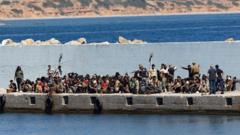The U.S. military base at Guantánamo Bay is set to house thousands of migrants, with 150 Venezuelans already transferred amid unclear circumstances, raising questions about the implications of such a controversial decision.
# Unveiling the Guantánamo Migrant Mission: A Complex Relocation of Venezuelans

# Unveiling the Guantánamo Migrant Mission: A Complex Relocation of Venezuelans
In a surprising move, the Trump administration relocates Venezuelan migrants to Guantánamo Bay, sparking controversy and concern.
The Trump administration has recently made headlines by transferring over 150 Venezuelan men from an immigration holding site in Texas to the U.S. military base at Guantánamo Bay, Cuba. All of these men are reportedly carrying final deportation orders, but the specific reasons for their selection remain undisclosed.
Historically, Guantánamo Bay has housed various migrant populations, including waves of Haitians and Cubans. However, it remains infamous primarily for detaining suspected terrorists captured following the events of September 11, 2001. This legacy has led to concerns surrounding the possibility of indefinite detention without due process, making it a precarious setting for the new arrivals.
On January 29, President Trump instructed the Defense and Homeland Security Departments to prepare the naval base for the potential influx of up to 30,000 migrants. Recent satellite images reveal that preparations for this unprecedented migration operation are already underway, including the erection of tents near facilities previously utilized for similar purposes.
As of the latest reports, approximately 850 military and civilian personnel have been assigned to assist with migrant operations at Guantánamo, with over 700 of them being active-duty military members. This unexpected and secretive operation continues to unfold, leaving many to ponder the legal and humanitarian implications of using a military facility for migrant containment.


















